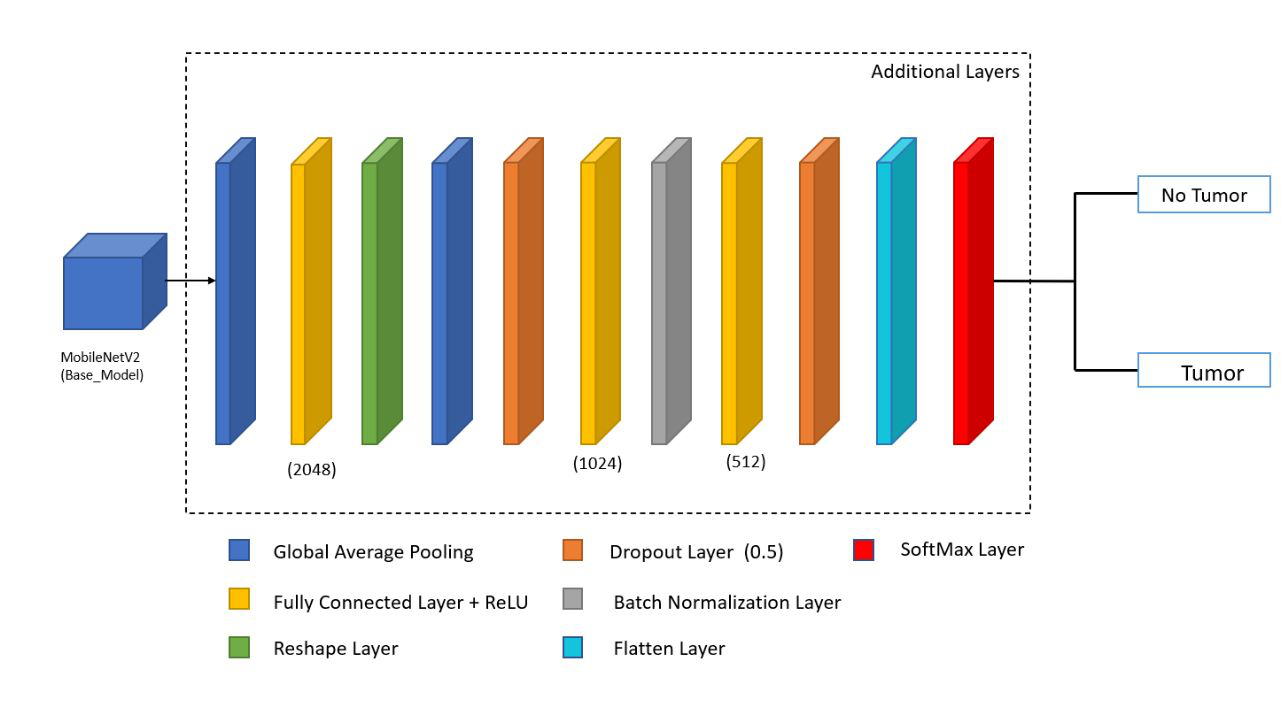Brain Tumor Detection by using Fine-tuned MobileNetV2 Deep Learning Model
Main Article Content
Abstract
Most of the deaths in the world happen due to Cancer. It is a disease in which the cells of our body organs or tissues grow in an undisciplined way which in turn can harm our normal cells and tissues in our body. These cells very smartly trick the immune system so that the cancerous cells are kept alive and are not destroyed. In the human body, tumors can be classified into three types: cancerous, non-cancerous, and pre-cancerous. Timely identification of the cancer can be helpful in many ways. As it improves a patient’s chances of survival. The most valuable, uncomplicated technique used is MRI scans for predicting tumor is a tough task and have chances of human error. So to be more accurate with our predictions we have moved on to use computerized techniques to ease the work. The focus of this research is the development of an automated brain tumor classification system using magnetic resonance imaging (MRI) scans, leveraging a deep learning model. The proposed model employs a convolutional neural network (CNN) architecture known as MobileNetV2, which is trained on a pre-processed MRI image dataset to classify brain tumors into one of two categories: tumor tissues and normal brain tissue. To mitigate overfitting and expand the dataset, data augmentation techniques are employed. The trained model achieves high accuracy, sensitivity, and specificity in classifying brain tumors. Proposed CNN model outperformed other deep learning models, including VGG16, Xception, and ResNet50, which were used for comparison.
Article Details
References
M. A. B. Siddique, S. Sakib, M. M. R. Khan, A. K. Tanzeem,M. Chowdhury, and N. Yasmin, ‘‘Deep convolutional neural networks model-based brain tumor detection in brain MRI images,’’ in Proc. 4th Int. Conf. I-SMAC (IoT Social, Mobile, Anal. Cloud) (I-SMAC), Oct. 2020,pp. 909–914.
J. Kang, Z. Ullah, and J. Gwak, ‘‘MRI-based brain tumor classification using ensemble of deep features and machine learning classifiers,’’ Sennsors, vol. 21, no. 6, p. 2222, Mar. 2021
R. Mehrotra, M. A. Ansari, R. Agrawal, and R. S. Anand, ‘‘A transfer learning approach for AI-based classification of brain tumors,’’ Machine Learn. with Appl., vol. 2, Dec. 2020, Art. no. 100003
Sangeetha, A. Mohanarathinam, G. Aravindh, S. Jayachitra, and M. Bhuvaneswari, ‘‘Automatic detection of brain tumor using deep learning algorithms,’’ in Proc. 4th Int. Conf. Electron., Commun. Aerosp. Technol. (ICECA), Nov. 2020, pp. 1–4
M. Li, L. Kuang, S. Xu, and Z. Sha, ‘‘Brain tumor detection based on multimodal information fusion and convolutional neural network,’’ IEEE Access, vol. 7, pp. 180134–180146, 2019.
S. Deepak and P. M. Ameer, ‘‘Brain tumor classification using deep CNN features via transfer learning,’’ Comput. Biol. Med., vol. 111, Aug. 2019, Art. no. 103345.
A Robust Approach for Brain Tumor Detection in Magnetic Resonance Images Using Finetuned EfficientNet Hasnain Ali Shah, Faisal Saeed, Sangseok Yun,Jun-Hyun Park, Anand Paul,And Jae-Mo Kang
Improving Effectiveness of Different Deep Transfer Learning-Based Models for Detecting Brain Tumors From MR Images Sohaib Asif,Wenhui Yi ,Qurrat Ul Ain3,Jin Hou,Tao Yi5and Jinhai Si
S. Paul, A. J. Plassard, B. A. Landman, and D. Fabbri, ‘‘Deep learning for brain tumor classification,’’ Proc. SPIE, vol. 10137, Mar. 2017,Art. no. 1013710.
A. Rehman, S. Naz, M. I. Razzak, F. Akram, and M. Imran, ‘‘A deep learning-based framework for automatic brain tumors classification using transfer learning,’’ Circuits, Syst., Signal Process., vol. 39, no. 2, pp. 757–775, Feb. 2020.
M. Talo, U. B. Baloglu, Ö. Y?ld?r?m, and U. R. Acharya, ‘‘Application of deep transfer learning for automated brain abnormality classification using MR images,’’ Cogn. Syst. Res., vol. 54, pp. 176–188, May 2019.
N. Noreen, S. Palaniappan, A. Qayyum, I. Ahmad, M. Imran, and M. Shoaib, ‘‘A deep learning model based on concatenation approach for the diagnosis of brain tumor,’’ IEEE Access, vol. 8, pp. 55135–55144, 2020.
A. Çinar and M. Yildirim, ‘‘Detection of tumors on brain MRI images using the hybrid convolutional neural network architecture,’’ Med. Hypotheses, vol. 139, Jun. 2020, Art. no. 109684.
P. Afshar, K. N. Plataniotis, and A. Mohammadi, ‘‘Capsule networks for brain tumor classification based on MRI images and coarse tumor boundaries,’’ in Proc. IEEE Int. Conf. Acoust., Speech Signal Process. (ICASSP), May 2019, pp. 1368–1372
G. Latif, G. B. Brahim, D. N. F. A. Iskandar, A. Bashar, and J. Alghazo, ‘‘Glioma Tumors’ classification using deep-neural-network-based features with SVM classifier,’’ Diagnostics, vol. 12, no. 4, p. 1018, Apr. 2022
A. R. Khan, S. Khan, M. Harouni, R. Abbasi, S. Iqbal, and Z. Mehmood,‘‘Brain tumor segmentation using K-means clustering and deep learning with synthetic data augmentation for classification,’’ Microsc. Res. Technique, vol. 84, pp. 1389–1399, Feb. 2021.
H. Yahyaoui, F. Ghazouani, and I. R. Farah, ‘‘Deep learning guided by an ontology for medical images classification using a multimodal fusion,’’ in Proc. Int. Congr. Adv. Technol. Eng. (ICOTEN), Jul. 2021, pp. 1–6
R. Chelghoum, A. Ikhlef, A. Hameurlaine, and S. Jacquir, ‘‘Transfer learning using convolutional neural network architectures for brain tumor classification from MRI images,’’ in Proc. 16th IFIP WG 12.5 Int.Conf. Artif. Intell. Appl. Innov. (AIAI), Neos Marmaras, Greece, vol. 583, Jun. 2020, pp. 189–200.

